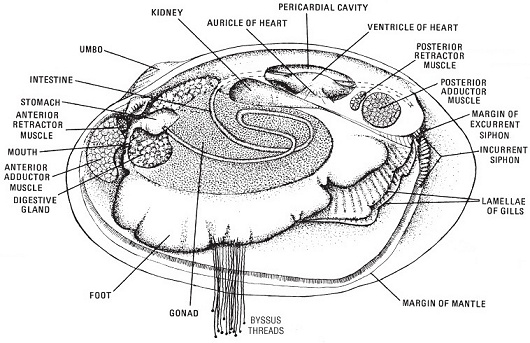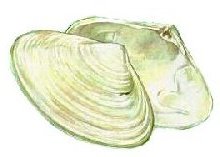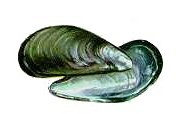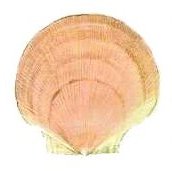Bivalves
All of these bivalves are filter feeders. The other major group of mollusks is the Gastropods or snails. Squid and octopus ( cephalopods ) are mollusks too, but they don't behave like other mollusks, so I included them elsewhere. Teredos are bivalves that have evolved a worm-like wood-boring habit.


The inshore wrecks are sometimes surrounded by the empty shells of Surf Clams Spisula solidissima, right, to 7" across. Large numbers of the white shells also wash up on beaches. Surf Clams are found subtidally down to 100 feet ( which makes you wonder why they are called surf clams. )
Tiny angel wing-shaped Coquina clams Donax variabilis less than 1 inch long do live in the surf, on wave-tossed sandy beaches.
More: Clams ...

Mussels are found everywhere, attached to any solid substrate. Mussels are to the sea what grass is to suburbia. Mussels lack the muscular foot of clams or the large hinge muscle of scallops. Instead, they have a "beard" of tough fibers near the hinge with which they attach themselves.
The Blue Mussel Mytilus edulis, to 4" is the edible mussel. The similar Horse Mussel Modiolus modiolus grows to 6", and is considered inedible. Both types are found from the intertidal zone down to the depths. See entry on barnacles.
More: Mussels ...

Scallops can swim in spurts by clapping their shells. Water is ejected backward through openings on either side of the hinge, propelling the scallop in the opposite direction - surprising to see for the first time. When not jetting around, they settle into evenly-spaced shallow pits in the sand.
The Deep Sea Scallop Placopecten magellanicus (right) grows to 8" and is found offshore, generally in water over 100' deep. The smaller but equally edible Bay Scallop Aquipecten irradians, to 3", is found in bays and protected shallow waters. The Bay Scallop has a deeply ribbed shell, while the Deep Sea Scallop has many tiny ribs.
More: Scallops ...

The Common Oyster Crassostrea virginica, to 10", is the basis of a major fishery, but they occur only in turbid brackish estuaries, conditions generally not conducive to scuba diving. Oysters once dominated the bottom fauna in our local rivers and bays, but are now all but extinct due to pollution and disease. Attempts are being made to reintroduce them in places, and perhaps someday even re-establish the fishery. Disease-resistant Asian Oysters may be the key to this.
More: Oysters ...

The Mermaid's Purse is not an invertebrate at all - it is a fish egg capsule. The egg capsule of a skate or ray, to be precise. The "horns" are to secure the capsule in seaweed. You may find one with a baby skate growing inside, but most are empty. They are included here with bivalves because they are often found scattered around the bottom like shells, up to 3" long. They certainly don't look like fish!
More: Mermaid's Purse ...

These animals are lumped together here because they all have hard external shells. Crustaceans and Mollusks are not closely related at all. This is more of a restaurant classification than a scientific one.
- American Lobster
- Crabs ...
- Other Crustaceans ...
More: Marine Shellfish ...
